Submitted by Gitie on 29 June, 2010 - 00:34
You may be a very kind and loving bird owner or you may not have birds at all. But please help spread this message so that we can create a kinder world for these beautiful creatures.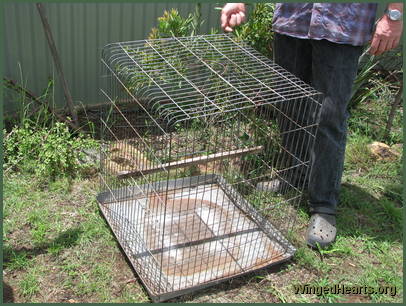
Pet birds are often confined to cages that are far too small for them to enjoy any reasonable quality of life. Canaries and budgies are sometimes kept in cages as small as a teapot. Large birds like cockatoos and african greys are lucky to be kept in cages as big as the one in the picture on the left. There is no room for the bird to even stretch their wings or get any exercise. The metal floor often a wire mesh is too harsh on their claws. The perches are also inappropriate as they are not suited to the size of their claws and the birds cannot flex their muscles. Sitting in a cramped position for a life time of imprisonment, the birds get cranky and bite. Then they are tagged as trouble makers and treated even worse. Large birds live for 60 -70 years in this form of confinement. The wire mesh on the sides of the cage often damage their wings and beaks.
Yet there are some easy ways of improving their quality of life in significant ways.

Submitted by Gitie on 27 June, 2010 - 01:50
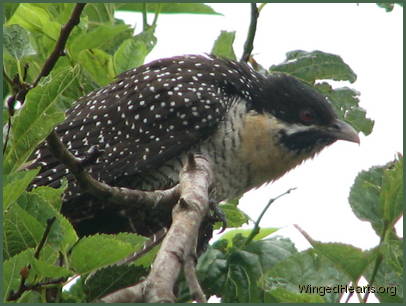 The first time a bird sees a camera, he/she may feel a bit unsure of the big thing we place next to our eyes that also makes a clicking sound. But in no time at all, they realise that the sound poses no danger to them. Once they become comfortable with the sound, they feel quite amused by our fondness for pointing this object towards them.
The first time a bird sees a camera, he/she may feel a bit unsure of the big thing we place next to our eyes that also makes a clicking sound. But in no time at all, they realise that the sound poses no danger to them. Once they become comfortable with the sound, they feel quite amused by our fondness for pointing this object towards them.
We use a Cannon S5 with a 1.5 teleconverter lens which is a reasonable sized equipment. To the bird it looks like we have added a big round black giant sized eye to our eye.
The birds have no idea what the camera really does for us, but that doesn't stop them from appreciating many things about it, in their classic style of observing our actions.

Submitted by Gitie on 27 June, 2010 - 00:13
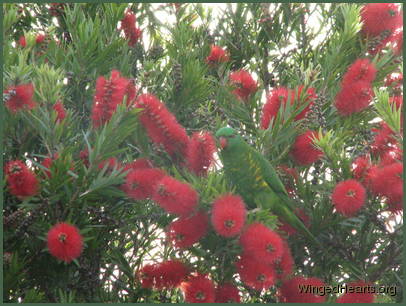 In order to understand birds, one has to pay attention with both ones ears and eyes. In other words we need to hear the sounds they are making while also following their actions. I call this 'Listening With Your Eyes'.
In order to understand birds, one has to pay attention with both ones ears and eyes. In other words we need to hear the sounds they are making while also following their actions. I call this 'Listening With Your Eyes'.
Birds love chattering and sharing the days news with each other. Every bird species has its own language. The different species don't have much difficulty following each other. The birds also have a range of soft almost inaudible 'mm', 'bb' type sounds and a lot of their communication is also non-verbal.

Submitted by Gitie on 26 June, 2010 - 00:19
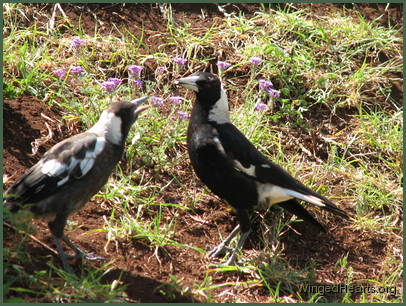 Today I'm going to show you some examples of the way birds use 'show and tell' as a way of communicating with us (and also each other).
Today I'm going to show you some examples of the way birds use 'show and tell' as a way of communicating with us (and also each other).
Consider the following two cases:
1. A group of magpies flies overhead headed towards the north. Our magpies sing out to them as they fly over. After a few chords they continue doing whatever activities had occupied them before.

Submitted by Gitie on 25 June, 2010 - 00:36
This is one of the first pictures I took of our birds back in 2001 with a film camera. (Any one remember those things that had to be handled carefully and in the dark?)
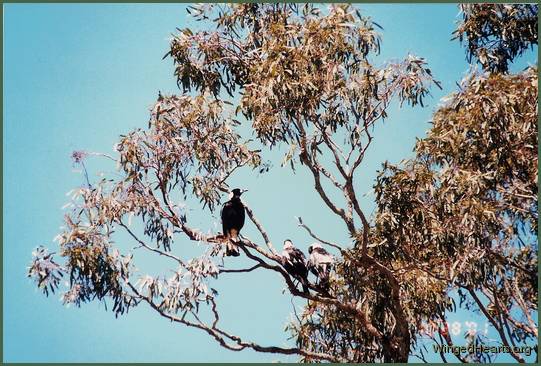
Here sitting on an old gum tree is Molly the mother magpie teaching juvis Maggie and Cindy to sing. They had the most brilliant voices and loved singing at top volume. This was during my early days of friendship with them.
In today's post we will explore tips 4-7 of getting to know your wild birds.

Pages


 The first time a bird sees a camera, he/she may feel a bit unsure of the big thing we place next to our eyes that also makes a clicking sound. But in no time at all, they realise that the sound poses no danger to them. Once they become comfortable with the sound, they feel quite amused by our fondness for pointing this object towards them.
The first time a bird sees a camera, he/she may feel a bit unsure of the big thing we place next to our eyes that also makes a clicking sound. But in no time at all, they realise that the sound poses no danger to them. Once they become comfortable with the sound, they feel quite amused by our fondness for pointing this object towards them. In order to understand birds, one has to pay attention with both ones ears and eyes. In other words we need to hear the sounds they are making while also following their actions. I call this 'Listening With Your Eyes'.
In order to understand birds, one has to pay attention with both ones ears and eyes. In other words we need to hear the sounds they are making while also following their actions. I call this 'Listening With Your Eyes'. Today I'm going to show you some examples of the way birds use 'show and tell' as a way of communicating with us (and also each other).
Today I'm going to show you some examples of the way birds use 'show and tell' as a way of communicating with us (and also each other).






